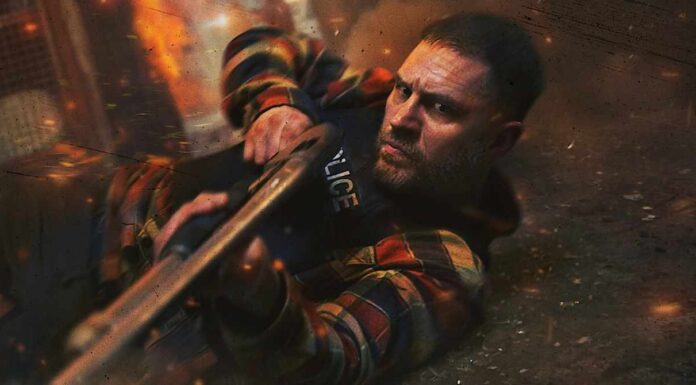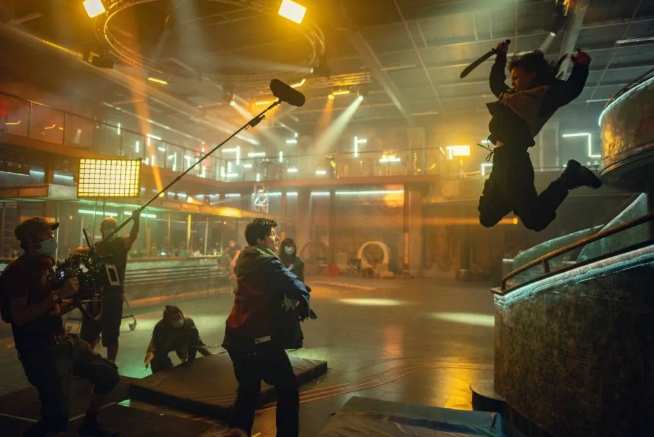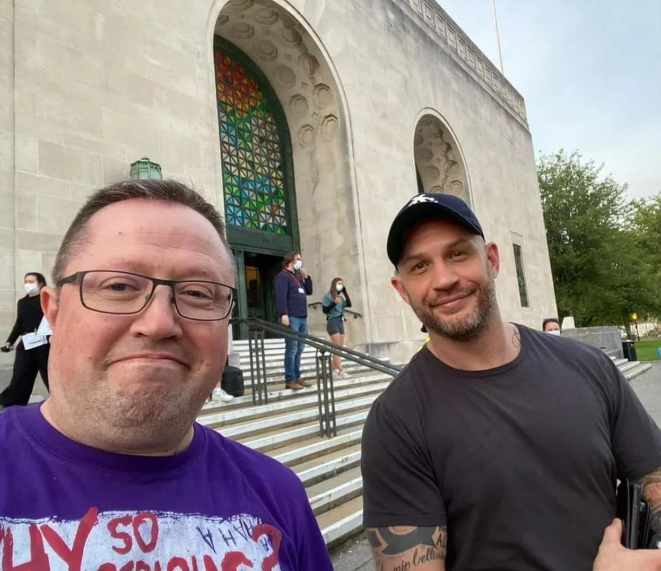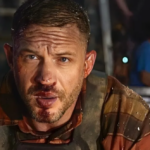The high-octane action thriller Havoc came out on Netflix on April 25, 2025. It was directed by Gareth Evans. The movie is about a jaded detective named Walker (Tom Hardy) who works in an American city that isn’t named—but is full of corruption. When a drug deal goes horribly wrong—Walker is told to save Lawrence Beaumont (Forest Whitaker), the estranged son of a corrupt politician. Along with Triad bosses, corrupt cops, and his own dark past, Walker has to deal with the criminal underworld. To help him, Ellie (Jessie Mei Li), a good cop trying to keep the city together, joins him.
This is Havoc’s world. It’s a neo-noir action thriller that looks and feels like it came straight from the dirty underbelly of a big American city. But here’s the catch: this dangerous cityscape wasn’t shot in New York, Chicago, or Detroit. The rolling hills and coastal towns of South Wales were instead used as a convincing stand-in for a dangerous U.S. city by director Gareth Evans.
Where did this movie magic happen, and how did Wales become the setting for one of Netflix’s most popular movies?
When and Where Was Havoc Filmed?
Filming for Havoc began on July 8, 2021 and wrapped on October 22, 2021, with principal photography taking place entirely in South Wales. Additional reshoots occurred in July 2024 due to scheduling issues and the SAG-AFTRA strike. Despite its American setting, the production leaned heavily on Welsh locations, supported by Creative Wales and local studios like Severn Screen. Cardiff, Swansea, Bridgend, Port Talbot, and other South Wales spots were meticulously dressed to mimic a wintry East Coast city. Gareth Evans, a Welsh native, scouted locations across Swansea, Cardiff, and Port Talbot, aiming to capture “30 to 40 percent” of the American aesthetic in-camera, with visual effects (VFX) handling the rest. The result? A seamless illusion that’s fooled even some American viewers, while Welsh locals might spot familiar landmarks disguised as gritty urban haunts.
Director Gareth Evans shared with Time Out the challenge of crafting an authentic cityscape for his film. He explained, “We drew inspiration from cities like New York, Chicago, Detroit, Pittsburgh and Philadelphia to create the world. Some Americans recognize parts of it but not as a whole, while people in Wales might think it’s Swansea.”
This clever use of real-world locations combined with visual effects to form an unforgettable, gritty city environment. Here’s a breakdown of the main filming locations for Havoc.
Cardiff, Wales
Cardiff, the lively capital of Wales, was the main location for Havoc’s production. Evans’ ideas were brought to life by the city’s unique mix of old buildings and new buildings. Bute Street, which is usually very busy, was turned into a snowy American boulevard with fake snow and Ford Crown police cars. Filmed at night in the summer, changing the street was a logistical feat and the people who lived there were very patient despite the problems. The Pierhead Building in Cardiff Bay was used for the interior of a police station, while Swansea’s Guildhall served for exterior shots. The team enjoyed transforming it into their version of an American precinct, despite the challenge of filming during a half-term fair, which required a two-day pause.
Seren Stiwdios, a cutting-edge facility in Cardiff, hosted the construction of a massive nightclub set for a pivotal fight scene. Evans described it as “an engineering feat,” with the art department crafting a multi-layered environment to accommodate Walker’s brutal showdown with gang members. AB Ports, located on the Severn Estuary, became a junkyard owned by Raul (Luis Guzmán), where tense encounters unfolded. Trade Street and Crockherbtown Lane also appeared, dressed with VFX to enhance their Americana vibe. Cardiff’s versatility allowed Evans to capture 30-40% of the city’s look in-camera, with visual effects filling in the rest.
Swansea: Grand Halls and Gritty Streets
Swansea, Wales’ second-largest city, played a starring role in Havoc. The iconic Brangwyn Hall, known for its ornate British Empire Panels, was transformed into multiple settings, including the exterior of a police precinct and a grand ballroom where Walker and Beaumont have a tense face-to-face. “We shot almost every corner of that space,” Evans said, praising its grandeur. The hall’s imposing architecture lent authenticity to the film’s high-stakes moments. Swansea University’s Bay Campus was the site of a dramatic limo ambush, where Triad assassin (Michelle Waterson) attacks Beaumont’s car. Evans noted the challenge of filming on Fabian Way, where half the road was real, and the rest was augmented with VFX to mask the surrounding countryside.
Other Swansea locations included the Kon-Tiki Bar, reimagined as a convenience store where Walker buys a Christmas gift for his child, and later repurposed for another scene. The Strand, Proud Mary, and Evening Post Cambrian House also featured, adding gritty urban textures to the film. Swansea’s ability to shift from elegant to rough-and-tumble made it a perfect fit for Havoc’s dual tones of corruption and chaos.
Bridgend: Studios and Seaside Serenity
Bridgend’s Dragon Studios provided soundstages for intricate set builds, including parts of the nightclub sequence and a fishing shack used in the film’s climactic moments. The nearby Merthyr Mawr countryside, with its windswept dunes and coastal charm, was the real-world location for Walker’s fishing shack. Evans, who previously filmed in Merthyr Mawr for Apostle, returned for a high-intensity sequence inspired by John Woo’s The Killer. Gareth Evans explained that they built wooden structures to shoot to pieces, blending on-location and stage work to capture the chaotic scenes. He also mentioned that Candleston Woods in Bridgend provided a rugged, isolated backdrop, enhancing the film’s atmosphere in its later acts.
Port Talbot: The Industrial Edge
Port Talbot, a coastal town with a strong industrial heritage, provided the setting for Havoc’s rail yard showdown at Baglan Bay Train. The location’s lumber yard, with logs stacked on trains, evoked an American aesthetic that Evans found ideal. “In the village I grew up in, you’d hear trains from the coal mines,” he recalled, emphasizing how Baglan’s unexpected Americana vibe was a perfect fit. The rail yard’s vast, open space allowed for a dramatic, large-scale sequence that capped the film’s action. Port Talbot’s raw, working-class character added authenticity to the story’s underbelly.
Sully and Barry Island: A Touch of Coastal Charm
In Sully, the residential street Lynmouth Drive was used for neighborhood scenes, offering a suburban contrast to the film’s urban core. Nearby, Barry Island Pleasure Park became a brief haven for Tom Hardy, who was spotted enjoying the seaside hotspot during filming breaks. While not a primary location, Barry’s inclusion highlighted the cast’s connection to the region’s community spirit. Hardy’s presence at the park sparked excitement among locals, with fans sharing selfies and stories of his down-to-earth demeanor.
Gareth Evans’ decision to film Havoc in Wales was a conscious one, and the decision was backed by the Welsh Government through Creative Wales. The region has become a popular destination for major TV and film productions, and Havoc is no exception. With a £28.6 million investment in the screen sector, Wales has seen a return on investment that has helped boost the local economy and create job opportunities for aspiring filmmakers and crew members.
The use of locations in South Wales not only gave the film a unique visual identity but also allowed Evans to explore the contrasts between the beauty of the natural landscape and the gritty urban environments that serve as the backdrop for the film’s story. The snow-covered streets, abandoned buildings, and industrial sites add a layer of realism and authenticity to the world of Havoc, making it feel like a living, breathing place.
Visit tvacute.com again soon for more Havoc news, filming insights, and updates on upcoming productions.
HAVOC ON NETFLIX: IS MEDUSA CLUB A REAL NIGHTCLUB?
HAVOC MOVIE ENDING EXPLAINED: IS WALKER ALIVE IN THE END?










